エンジェルビーツ
Angel Beats! — Final Thoughts (Review)
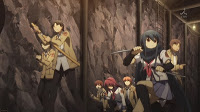 I’m not one for hyped anime titles. Indeed, my interest in Angel Beats! lay not with the hype surrounding the start of it (I paid scant attention to that), but rather the fact that Maeda-sensei, creator of Key titles Air, Kanon, and Clannad, was the creator of Angel Beats! as well. While it is nice to have a Key anime title that isn’t bound by the restrictions of the source visual novel, Angel Beats! suffers from other problems.
I’m not one for hyped anime titles. Indeed, my interest in Angel Beats! lay not with the hype surrounding the start of it (I paid scant attention to that), but rather the fact that Maeda-sensei, creator of Key titles Air, Kanon, and Clannad, was the creator of Angel Beats! as well. While it is nice to have a Key anime title that isn’t bound by the restrictions of the source visual novel, Angel Beats! suffers from other problems.
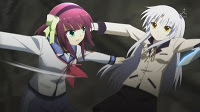 We in the West are not fond of multi-media releases. If we watch a TV series, then we expect the TV series to be self-contained. If we watch a movie series, we expect that to be self-contained. There are exceptions of course, such as the comic book used to bridge the aborted Firefly TV series with the Serenity movie, but even then, most folks prefer to skip the comic book portion and just stick to the TV series and movie. In
We in the West are not fond of multi-media releases. If we watch a TV series, then we expect the TV series to be self-contained. If we watch a movie series, we expect that to be self-contained. There are exceptions of course, such as the comic book used to bridge the aborted Firefly TV series with the Serenity movie, but even then, most folks prefer to skip the comic book portion and just stick to the TV series and movie. In 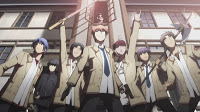 Japan, the culture is a little different, no doubt due to the otaku collectors mentality that supports the overpriced products in Japan. As such, having an anime series that is covered in part in a video game, novel, manga, 4-koma (comic strip), or combination of those elements isn’t seen negatively.
Japan, the culture is a little different, no doubt due to the otaku collectors mentality that supports the overpriced products in Japan. As such, having an anime series that is covered in part in a video game, novel, manga, 4-koma (comic strip), or combination of those elements isn’t seen negatively.
Thus, we come to this 13-episode anime series called Angel Beats! which has story elements that cover not only the anime, but a novel, a manga, and a 4-koma series. In other words, the bane of the West.
 The anime gets off to a rocky start by first appearing to have lead female character Yuri look similar to Haruhi from the famous Suzumiya Haruhi franchise. Then, the anime appeared to pick up elements that were deemed to be popular. It also started with a blood-fest for comedy that did not work for me. None of the characters really stood out to me and I found myself wondering, “What’s the point?”
The anime gets off to a rocky start by first appearing to have lead female character Yuri look similar to Haruhi from the famous Suzumiya Haruhi franchise. Then, the anime appeared to pick up elements that were deemed to be popular. It also started with a blood-fest for comedy that did not work for me. None of the characters really stood out to me and I found myself wondering, “What’s the point?”
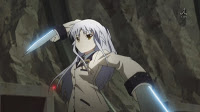 Fortunately, things did improve. Learning Yuri’s horrible backstory (though not the cause of her death) gave some meaning to her desire to call out God and pursue the person she has deemed an angel and thus named her “Tenshi,” the Japanese word for angel. Learning of Yui’s life explain a lot of her actions in the afterlife and the resolution of her storyline was the one tearful moment for me, but in a happy sort of way.
Fortunately, things did improve. Learning Yuri’s horrible backstory (though not the cause of her death) gave some meaning to her desire to call out God and pursue the person she has deemed an angel and thus named her “Tenshi,” the Japanese word for angel. Learning of Yui’s life explain a lot of her actions in the afterlife and the resolution of her storyline was the one tearful moment for me, but in a happy sort of way.
 The comedy aspects to improve as well as the bloody gore is dropped for more traditional “death” comedy akin to something that might have come out of the classic Looney Tunes. There are character comedy moments as well such as when Yui and Hinata pick on each other, almost like a brother and sister, thus showing how they actually do care for each other. The character of TK, who speaks clear but bizarre English and Japanese, is a fan favorite
The comedy aspects to improve as well as the bloody gore is dropped for more traditional “death” comedy akin to something that might have come out of the classic Looney Tunes. There are character comedy moments as well such as when Yui and Hinata pick on each other, almost like a brother and sister, thus showing how they actually do care for each other. The character of TK, who speaks clear but bizarre English and Japanese, is a fan favorite  because of his sayings, which can be funny. He grew on me and should this anime be licensed, the U.S. company would do well to hire the same person to do the voice — Michael Rivas (or use his voice track from the Japanese). If the U.S. dub doesn’t do the same Japanese/English mix, his character won’t be the same and Michael just has that nailed.
because of his sayings, which can be funny. He grew on me and should this anime be licensed, the U.S. company would do well to hire the same person to do the voice — Michael Rivas (or use his voice track from the Japanese). If the U.S. dub doesn’t do the same Japanese/English mix, his character won’t be the same and Michael just has that nailed.
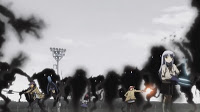 The overall plot is rather interesting for the most part, but the anime is completely unpredictable. So if you haven’t yet watched this, don’t bother trying to figure out anything because you almost certainly will be wrong. There’s nothing wrong with an anime, manga, book, etc. being unpredictable. However, some of that unpredictability comes from the lack of proper setup due to only having thirteen episodes to work with.
The overall plot is rather interesting for the most part, but the anime is completely unpredictable. So if you haven’t yet watched this, don’t bother trying to figure out anything because you almost certainly will be wrong. There’s nothing wrong with an anime, manga, book, etc. being unpredictable. However, some of that unpredictability comes from the lack of proper setup due to only having thirteen episodes to work with.
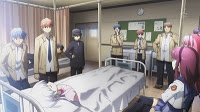 Ultimately, that’s what is wrong with this anime. Having only thirteen episodes to work with meant that some story elements, including important backstory of how Yuri and Tenshi met as well as how Hinata came into the story and how the so called “NPC’s” weren’t always what one would expect them to be. More episodes would have helped the overall plot greatly and allowed for more character development, something that was limited to a select few characters. I’m not sure that what I’ve seen of the prequel novel fills in enough of the gaps and I know nothing of what is in the manga or 4-koma strips.
Ultimately, that’s what is wrong with this anime. Having only thirteen episodes to work with meant that some story elements, including important backstory of how Yuri and Tenshi met as well as how Hinata came into the story and how the so called “NPC’s” weren’t always what one would expect them to be. More episodes would have helped the overall plot greatly and allowed for more character development, something that was limited to a select few characters. I’m not sure that what I’ve seen of the prequel novel fills in enough of the gaps and I know nothing of what is in the manga or 4-koma strips.
I walked away from this anime with the following list of unanswered questions.
- Where was ‘God?’
- How’d all these kids learn to create guns? The anime was clear that while weapons could be made from dirt, the makers had to know how to make a weapon from memory in order to make it from dirt. That was further expanded when the Guild produced a giant cannon to attack Tenshi with and it blew up on them because they didn’t know how to properly make it. Yet somehow, they knew how to make a dizzying array of other weapons (see this impressive article on the actual weapons used in the anime).
- Why were all of the souls in this “purgatory” high school aged kids, save for Chaa (and I only know he was not because that’s revealed in the novel)?
- If Kanade (Tenshi) was the recipient of Otonashi’s heart after he passed away, then how’d she end up in “purgatory” before Otonashi, and by a significant amount of time too?
- How’d Yuri know where Otonashi would arrive so she could immediately recruit him?
- Why’d Yuri think that Kanade was an angel just because she could do certain things considering that her people could create weapons from dirt, something equally as amazing?
- Just how in the heck did the person that created this purgatory world do so?
- Why was Yuri so concerned about not harming NPC’s? If they weren’t human but merely creations, then what did it matter whether they were hurt or not? If they were human souls, then again, what did it matter since people who “die” in this purgatory world come back to life?
- Speaking of death, why was Naoi’s slaughtering the SSS worse than when Tenshi did it? Yes, he could force-send them on, but not if they were “dead.”
- How come it took time for Yui and Iwasawa to find the contentment to move on but suddenly at the end, the 99% of the SSS organization is sent on in a very little time within purgatory?
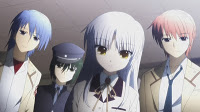 In the end, Angel Beats! is an anime with promise and with some elements that are really good. However, the lack of episodes is a real killer here as it prevents proper character development and proper story development. The good elements and episodes are enough to make it worth a rent though.
In the end, Angel Beats! is an anime with promise and with some elements that are really good. However, the lack of episodes is a real killer here as it prevents proper character development and proper story development. The good elements and episodes are enough to make it worth a rent though.



 July 11th, 2010
July 11th, 2010  AstroNerdBoy
AstroNerdBoy 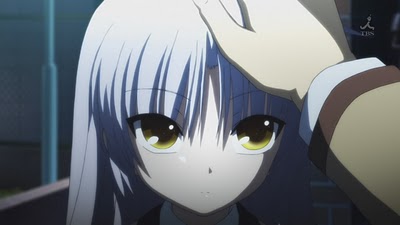
 Posted in
Posted in  Tags:
Tags: 
Agree with you for the most part ANB, Angelbeats was a good but flawed series and needed 20+ episodes if it was to be developed properly.
My main complaint is not so much that everything was not explained but rather that there was not enough set up for the things that were explained with the ending being the prime example.
That being said I would quite like to see a sequel (or prequel) even if it has a different cast of characters which could go into the “mythology” a bit more
So very true, Angel Beat! seriously needed at least a 25 episode season. Like all other creations of Jun Maeda (save for Air). If it had gotten a 25 episode season then we possibly could put it on par with his other successful titles.
I had really hoped that it would become like that, he has a chance to redeem himself though if he makes another season for it, but the chances of that is like hoping a tree starts growing anime.
Thanks for your insight ANB, cheers mate.
I agree with everything you said, but I think I might offer a possible reason for the SSS’s quick disappearance:
They had all reached a resolution of some sort or were near to one, and simply stayed around because of strong feelings of camaraderie towards one another. Once their leader gave them the choice to stay or move on, and they realized that moving on would not necessarily be a bad thing, they made their choice happily.
–Pillslanger
For #9, I think it’s because Naoi turns out to be a sadist. We have the one brief scene in which Yuri finds him kicking a student who’s gone fetal on the roof of one of the school buildings, and the implication is that there’s no reason for the beating except that Naoi enjoys it.
Tenshi ignored people who were no longer a threat. Naoi would look for excuses to physically abuse anyone and everyone who crossed his path.
I can answer of the questions
The manga is an illustration of the light novel so nothing new there. The 4-koma is just comedy. It further shows some of the character’s personalities ways but don’t shed any real light on the world
i) Where was ‘God?’
Unknown. Possibly does not exist. Its left to the viewer so as not to offend
i) How’d all these kids learn to create guns?
There are some people known as gun otaku, which pretty much means gun nuts (something like the people who made the article you linked to) and an exmaple is shown in highschool of the dead
iii)Why were all of the souls in this “purgatory” high school aged kids, save for Chaa (and I only know he was not because that’s revealed in the novel)?
Chaa is the same age as the rest as shown in the light novel. In fact he astonished Yuri, Hinata and Ooyama when he told them that. As noted by Tenshi, the world is made for those with fufilled youth
iv) If Kanade (Tenshi) was the recipient of Otonashi’s heart after he passed away, then how’d she end up in “purgatory” before Otonashi, and by a significant amount of time too?
Otonashi was noted as having wandered in, so where he wandered from is unknown as is the time reference. I believe the unnatural conversation between Hinata and Otonashi was an attempt to hammer this in in episode 13 prior to the big reveal later
v) How’d Yuri know where Otonashi would arrive so she could immediately recruit him?
Unknown.
vi) Why’d Yuri think that Kanade was an angel just because she could do certain things considering that her people could create weapons from dirt, something equally as amazing?
The difference lies in the RLness of the ability. Dirt ends up making guns and other RL stuff. Tenshi “grew” a blade from her wrist, which does not look anywhere near RL. Thus Tenshi = Special = Possible world guardian
vii)Just how in the heck did the person that created this purgatory world do so?
The programmer did not create the world. Who made it is unknown but it has existed for a long time (possibly with a different look)
viii) Why was Yuri so concerned about not harming NPC’s?
She wasn’t initially since she planned to slaughter them all. Hinata dissuaded her and when Ooyama was shown to be huiman when they thought he was an NPC, it made sense not to kill the NPCs and it would make them look bad to anyone who would have joined.
The NPCs can be manipulated directly (shadows), humans cannot. So it stands as a distinction that NPCs are not human
ix) Speaking of death, why was Naoi’s slaughtering the SSS worse than when Tenshi did it?
Two things, first the underhandedness of using NPC human shields and the force send off making them live a lie. As noted by Otonashi (who i believe was speaking for the writer), its better to remember living a life that was real but bad than to remember life as a lie
x) How come it took time for Yui and Iwasawa to find the contentment to move on but suddenly at the end, the 99% of the SSS organization is sent on in a very little time within purgatory?
Lack of episodes and the desire to push non-critical stories out into another medium (much like star wars/star trek novels). Heck they could even make a visual novel or RPG out of it.
Also from Yui’s example, i believe its a single regret that holds them back. The wrestling, soccer, etc were all fun but not critical. If they could understand and accept that regret, they would move on even if they did not fufil the small stuff
ANB wrote:
“In Japan, the culture is a little different, no doubt due to the otaku collectors mentality that supports the overpriced products in Japan. As such, having an anime series that is covered in part in a video game, novel, manga, 4-koma (comic strip), or combination of those elements isn’t seen negatively.”
This is why Angel Beats! needed to be paced at a 24-26 episode season, especially for those who do not have the supplementary material. The sheer amount of backstory and supplemental materials (trope equivalent=”All There in the Manual”) needed is what seems to confuse a lot of people outside Japan regarding the show. If we knew what some of the material was coming into watching Angel Beats!, it would definitely be more enjoyable. As I mentioned in the previous thread for Angel Beats!, the best representation of enjoyability here is a bell curve, and I was almost put off by the chaotic first episode and the rushed last couple of episodes.
On a different tangent, I guess this is why Nanoha did not sell well in the States. The original and A’s had relatively modest sales (part of it is because it is packaged like a magical girl show while we know all the mecha overtones), but Nanoha is another show plagued with backstory material (the Sound Stages, the Strikers manga, etc.). There’s almost no chance that Strikers or the current manga will be licensed.
I know that anime and manga have to be licensed separately, and there are virtually no visual novels out west, but is there a possibility that all the materials can be bundled as a “package” for licensing? I know that this would raise the fees, however, so this is a sticky situation to begin with.
@Mister_Random — Not enough setup, such as having “The Architect” from The Matrix show up in younger form? *lol* That was completely out of nowhere.
@Jayce — With his previous successes and the hype surrounding this anime, I wonder why the sponsors decided only to fund 13-episodes.
@Pillslanger — I guess I could buy that.
@Junior — I could buy that too.
@Anon — Regarding Chaa, there’s this from the Angel Beats! Wikia site.
Tenshi then invites everyone, including the gunman, into her dormitory room, where she prepares tea as promised. The gunman then introduces himself as Chaa and he starts to tell more about why he is in the afterlife, particularly his life that seemed to end when her beloved wife left him after their promise to look for utopia made for the two of them. Yuri then assures her that he is not alone in this world, and he begins to sob.
I think there’s a typo and they mean “…his beloved wife…” That implied to me that Chaa is older if he had a wife.
Thanks for the other answers.
Oh, and about the Google errors, that seems to happen when there are too many characters in a comment.
@Kirbstar — This is why Angel Beats! needed to be paced at a 24-26 episode season, especially for those who do not have the supplementary material. The sheer amount of backstory and supplemental materials (trope equivalent=”All There in the Manual”) needed is what seems to confuse a lot of people outside Japan regarding the show.
The Japanese create shows for Japanese, not Western audiences. It is a highly unfortunate circumstance. To be honest, we in the West (or to be more specific, ANY of us outside of Japan) are just an afterthought. Sadly, those who license stuff outside of Japan don’t grab everything related. As I said, we in the West do not like multi-media releases but in Japan, those are not uncommon.
I still don’t know why the Japanese sponsors didn’t fund for a full 26-episode release of the anime because I bet that would have been preferred.
As to Nanoha, it is funny how this spinoff character from a porn visual novel (and subsequent, non-hentai 4-episode OVA) called Triangle Heart became the star. I don’t recall Nanoha or Nanoha A’s having additional canon materials to the story as the manga were just adaptations. That said, I do know that there was a canon manga created to bridge the gap between A’s and StrikerS. Indeed, StrikerS references an event that happens in that manga.
@ANB
You’re right, Chaa is married but he’s not old. His wife’s disappearence is also his regret, i believe. Here’s the excerpt in the light novel when he told the others
**********
Ooyama and I shouted at the same time once again.
“Hey, you’re still a high school student right? You’re already married?”
“Yes. However, we decided to set off on a journey to look for a utopia that belonged to only the two of us. A utopia that didn’t exist in reality… A distant world…”
**********
If you still curious, some peeps translated the novels over at http://www.mediafire.com/angelbeatstrackzero
Your synopsis made me have .hack flashbacks.
I have to admit, I was disappointed at the lack of character development myself. I really wanted to see what drove TK, the ninja girl, and that Axe Crazy guy. I was also hoping Yuri would reveal what killed her, but I guess that’s insignificant, or they would have revealed it.
But what really killed everything was the ending. I absolutely HATE you-imagine-what-happens-next endings. I don’t want to imagine what happens, I want the truth. I want to know what REALLY happened to all the characters. The worst offenders I’ve seen of these endings are the following (you can skip this part, I just wanted to ramble here):
___________________________________
Kaiba (The main character destroys the planet eating monster, floats to the ground, and the series ends without resolving a lot of things)
Tokyo Majin (The bad guy isn’t defeated, and one of the characters pursues him in rage, and his friend decides to follow him to smack some sense into the his friend, and the series ends without really resolving what happened to some of the people after Tokyo was completely destroyed).
.hack//SIGN (Morganna who is the evil AI of the world sends out Skeith to fight the heroes, and then the series ends with Tsukasa waking up to find he’s actually a girl without telling the audience what happened in the battle. The games imply that Skeith survived, so what on earth happened?
___________________________________
So I want to know, why do people use endings like this? What is the point? Is it to see if fans want a sequel?
So I want to know, why do people use endings like this? What is the point? Is it to see if fans want a sequel?
Just a quick response since I’m pressed for time. My understanding is that there is a preference in Japan for “make up your own endings” in stories. I suppose one could argue that this is a driving force behind the popularity of visual novels, both H and non-H. So, if you want “this” romantic pairing or “that” romantic pairing, there’s nothing to say that didn’t happen if the anime writers leave things open ended.
To answer the question for how Yurippe knew how to find him so she could recruit him, if you remember he wakes up, who knows how long he’s been asleep, it might be like when people die there they then wake up again later so this was his first “waking up”.
I suppose that’s possible.
I just finished this and it’s too my amazement that back when you initially did this review I made a reference to .hack based off your synopsis. I would like to say that this series was a nice mix of familiar anime elements being used in an original manner. What really got me was that, despite the comedy, the series had a very melancholy feel to it. The bittersweet ending (not counting the OAV) was very touching as well. It’s interesting how there’s more media related to the series but I think it made it’s general point within the TV series where at least the main characters stories were “resolved”. I also think that, despite your complaints, this would appeal to the Haruhi crowd because it does have a few overlapping story elements (high school characters being in a deceptively unusual deity-esque scenario, a balance between dark plot elements and comedy, the main characters are pretty much Kyon and Haruhi expys to an extent, some of Otanashi’s dynamics with Tenshi are similar to another dynamic in Haruhi.). I’m glad this was a blind buy for me. It’s kind of sucky though it’s hard to recommend anime to friend’s these days, though. The people I know who are familiar with anime have either moved on from it, or part of a con-going mentality where they tend to watch a lot of superficial “popular” series.